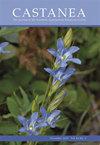2022 Richard and Minnie Windler Award Recipients
IF 0.3
4区 生物学
Q4 PLANT SCIENCES
引用次数: 0
Abstract
The Richard and Minnie Windler Award recognizes the authors of the best systematics and ecology papers published in Castanea during the previous year. For 2020, authors of two articles were selected as winners: Erika R. Moore, Carolina M. Siniscalchi, and Jennifer R. Mandel for their article, “Reevaluating genetic diversity and structure of Helianthus verticillatus (Asteraceae) after the discovery of new populations” (Castanea 86[2]:196–213), and Nicole M. Fama, Brandon T. Sinn, and Craig F. Barrett for their article, “Integrating genetics, morphology, and host specificity in conservation studies of a vulnerable, selfing, mycoheterotrophic orchid.” (Castanea 86[1]:1–21). The whorled sunflower (Helianthus verticillatus Small) is a federally listed endangered plant known from six disjunct populations occurring in Alabama, Georgia, Mississippi, Tennessee, and Virginia. Employing microsatellite data to explore genetic structuring and diversity of these populations, Moore and her colleagues discovered that though differentiated, these populations had high allelic diversity. The most recently discovered populations in Mississippi and Virginia had experienced genetic bottlenecks. Because the whorled sunflower is self-incompatible, such bottlenecks may have led to increased reliance on asexual reproduction in these populations. Nevertheless, these populations are genetically distinct, and harbor alleles important to the diversity of the species as a whole. Given the small size and unique genetic constitution of each population, species conservation necessitates protecting as many of these populations as possible.2022年Richard和Minnie Windler奖获得者
Richard和Minnie Windler奖表彰了前一年发表在Castanea上的最佳系统学和生态学论文的作者。2020年,两篇文章的作者被选为获奖者:Erika R.Moore、Carolina M.Siniscalchi和Jennifer R.Mandel的文章《在发现新种群后重新评估垂直向日葵(菊科)的遗传多样性和结构》(Castanea 86[2]:196–213),Nicole M.Fama、Brandon T.Sinn和Craig F.Barrett的文章,“将遗传学、形态学和寄主特异性整合到脆弱、自立、分枝异养兰的保护研究中。”(Castanea 86[1]:1-21)。轮生向日葵(Helianthus verticillatus Small)是一种联邦濒危植物,分布在阿拉巴马州、佐治亚州、密西西比州、田纳西州和弗吉尼亚州的六个不连续种群中。利用微卫星数据来探索这些种群的遗传结构和多样性,Moore和她的同事发现,尽管这些种群存在差异,但具有较高的等位基因多样性。密西西比州和弗吉尼亚州最近发现的种群经历了基因瓶颈。由于轮生向日葵是自交不亲和的,这些瓶颈可能导致这些种群越来越依赖无性繁殖。尽管如此,这些种群在基因上是不同的,并且具有对整个物种多样性重要的等位基因。鉴于每个种群的体型较小,基因结构独特,物种保护需要尽可能多地保护这些种群。
本文章由计算机程序翻译,如有差异,请以英文原文为准。
求助全文
约1分钟内获得全文
求助全文
来源期刊

Castanea
生物-植物科学
CiteScore
0.50
自引率
25.00%
发文量
28
审稿时长
>12 weeks
期刊介绍:
Castanea is named in honor of the American Chestnut tree. Castanea is thebotanical name for Chestnuts, dating back to what the ancient Greeks calledthem.
The American Chestnut is a critically endangered tree that once made up 35%of the forests of the Eastern US before being devastated by a blight thatdestroyed up to 4 billion American Chestnut trees.
Castanea serves professional and amateur botanists by reviewing andpublishing scientific papers related to botany in the Eastern United States.
We accept papers relating to plant biology, biochemistry, ecology, floristics,physiology and systematics.
 求助内容:
求助内容: 应助结果提醒方式:
应助结果提醒方式:


